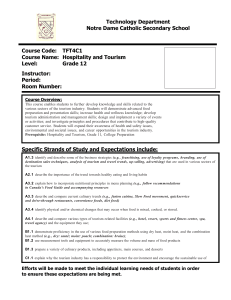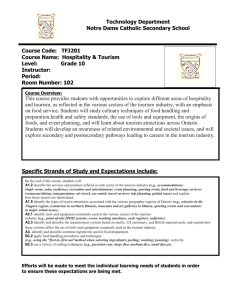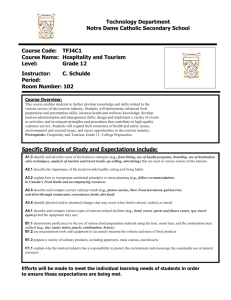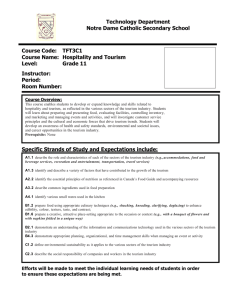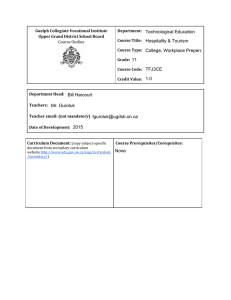Technology Department Notre Dame Catholic Secondary School Course Code: TFJ201
advertisement
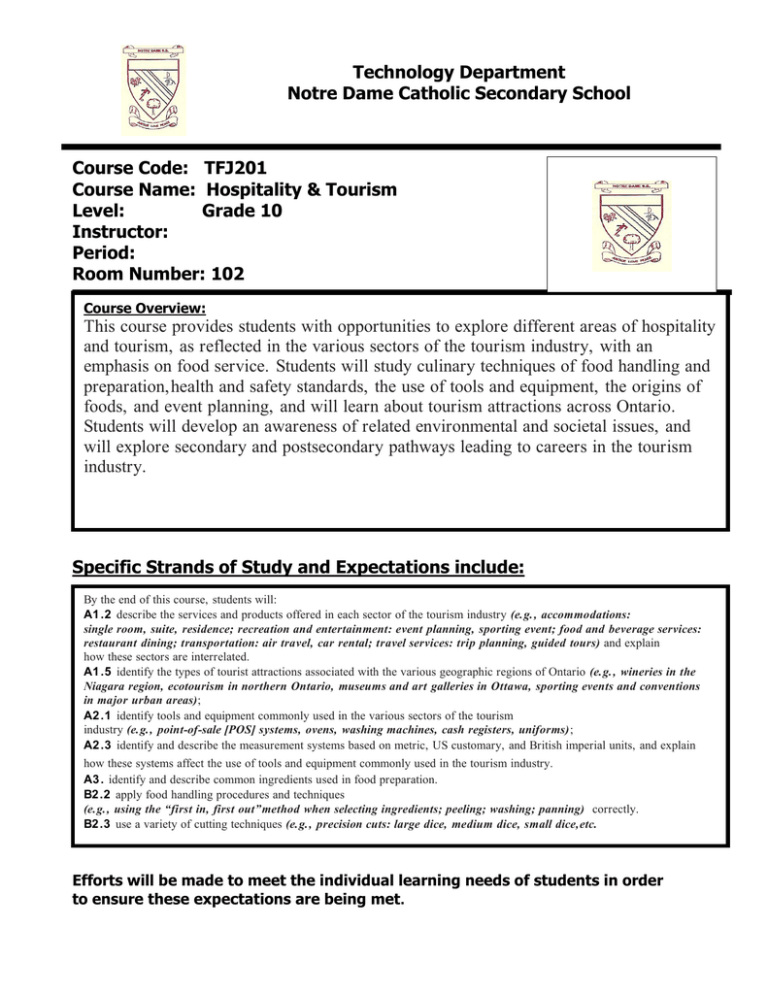
Technology Department Notre Dame Catholic Secondary School Course Code: TFJ201 Course Name: Hospitality & Tourism Level: Grade 10 Instructor: Period: Room Number: 102 Course Overview: This course provides students with opportunities to explore different areas of hospitality and tourism, as reflected in the various sectors of the tourism industry, with an emphasis on food service. Students will study culinary techniques of food handling and preparation,health and safety standards, the use of tools and equipment, the origins of foods, and event planning, and will learn about tourism attractions across Ontario. Students will develop an awareness of related environmental and societal issues, and will explore secondary and postsecondary pathways leading to careers in the tourism industry. Specific Strands of Study and Expectations include: By the end of this course, students will: A1 .2 describe the services and products offered in each sector of the tourism industry (e.g., accommodations: single room, suite, residence; recreation and entertainment: event planning, sporting event; food and beverage services: restaurant dining; transportation: air travel, car rental; travel services: trip planning, guided tours) and explain how these sectors are interrelated. A1 .5 identify the types of tourist attractions associated with the various geographic regions of Ontario (e.g., wineries in the Niagara region, ecotourism in northern Ontario, museums and art galleries in Ottawa, sporting events and conventions in major urban areas); A2 .1 identify tools and equipment commonly used in the various sectors of the tourism industry (e.g., point-of-sale [POS] systems, ovens, washing machines, cash registers, uniforms); A2 .3 identify and describe the measurement systems based on metric, US customary, and British imperial units, and explain how these systems affect the use of tools and equipment commonly used in the tourism industry. r ism In d ust r y A3 . identify and describe common ingredients used in food preparation. B2 .2 apply food handling procedures and techniques (e.g., using the “first in, first out”method when selecting ingredients; peeling; washing; panning) correctly. B2 .3 use a variety of cutting techniques (e.g., precision cuts: large dice, medium dice, small dice,etc. Efforts will be made to meet the individual learning needs of students in order to ensure these expectations are being met. Course Breakdown Resources: Unit 1: Tourism Unit 2: Safety & Sanitation Unit 3: Food Prep and Handling Unit 4: Food Origins Unit 5: Communication & Management Skills 25 hours 25 hours 40 hours 10 hours 10 hours The course will use a variety of resources including video, CD-ROM, Internet Applications and a variety of print sources. The textbook Culinary Essentials will be distributed to students occasionally during the course. The text and all other resources assigned to students are the responsibility of the student. Any damage incurred will result in payment for replacement. Replacement cost for the text is $80.00. Evaluation Structure:: Knowledge/Understanding Thinking/Inquiry Communication Application 20% 20% 25% 35% The above is reflected both in the term work (worth 70% of the final mark) and the summative work (worth 30% of the final mark). Summative work consists of the Final Exam (15%) and culminating activity (15%). Evaluation Policy Students will be assessed & evaluated according to the work produced & skills displayed. Methods of providing feedback will include assessing work in process & evaluating completed assignments, tests, co-operative learning activities, simulations and presentations. Peer & self-evaluations will also be utilized. Student marks will be determined by evaluating process & product according to 4 categories & 4 levels. Please see the chart below for specific skills and key words used to determine student competency in the different categories. Level Category Knowledge/Understanding Knowledge of facts & terms Understanding of concepts & relationships Thinking/Inquiry Critical thinking skills Creative thinking skills Inquiry Skills Communication Communication of ideas and information Use of symbols & visuals Oral & written communication Level 1: 50-59% Level 2: 60-69% Level 3: 70-79% Level 4: 80-100% -Limited display of knowledge, skills and ability to apply concepts -Some success in displaying knowledge, skills and application of concepts -Considerable display of knowledge skills and ability to apply concepts -Thorough understanding of concepts and ability to communicate, think creatively and apply concepts Application Applications in familiar contexts Transfer of concepts to new contexts Making logical conclusions and predictions Use of technology Making connections Feedback will also be provided for student learning skills. Skills like working independently, team work, organization, work habits and homework, and initiative are assessed independently student achievement and will be conducted through the use of a rubric indicating specific criteria to be achieved to receive each of the following letter grades: E –Excellent Other Evaluation Issues G – Good S – Satisfactory N - Needs Improvement LATE ASSIGNMENTS. Assignments submitted after the Primary Due Date established by the teacher will be accepted with a penalty of 5% off for the first day late, 2% for the second day late, 2 % for the third day, etc., to a maximum of 10%. This four day Penalty Zone is the maximum time allowed for submissions. The fourth day after the assignment is due is considered the Closure Date upon which no further assignments will be accepted. If the teacher returns the marked assignments within the four day penalty zone, the date of return is considered the closure date. Repeated lateness in submissions indicates poor organization skills and will result in parental contact and will be reflected in the learning skills section of the report card. INCOMPLETE ASSSIGNMENTS Assignments will be graded according to the extent with which they meet the criteria established in the rubric or evaluation structure. MISSED TESTS Tests missed with a legitimate reason will be written within a few days of the student returning from the absence. Student eligibility to write the test and the date of writing will be at the discretion of the teacher in consultation with the department head. Plagiarism in any form reflects academic dishonesty and will result in a mark of zero for the assignment in question
